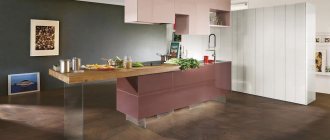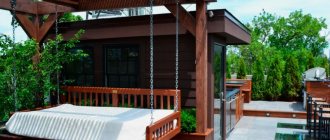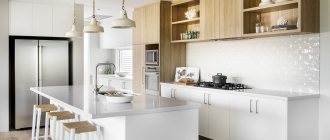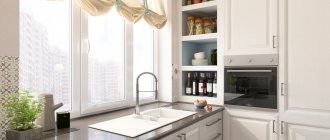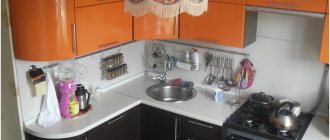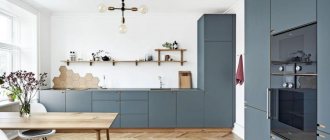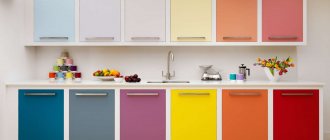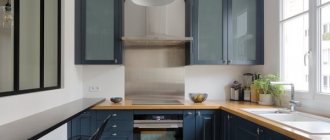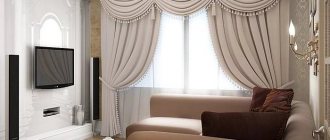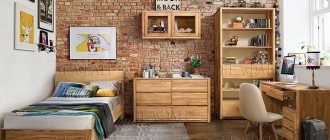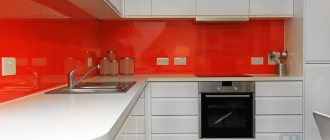It’s hard to surprise a modern person, but technology continues to develop and designers have created something radically new: a wall-hung kitchen. This headset has no legs and seems to float in the air. Hence the name “floating kitchen”.
But how convenient and reliable is such an innovation?
Types of kitchens without support
The usual appearance of a kitchen set suggests that it rests firmly with its legs on the floor, where the weight of the lower cabinets and countertops falls. In a support-free design project, both the upper and lower line of the headset - cabinets and modules - are fixed on the wall. Of course, the fastenings, like the wall itself, must be ready for heavy loads and reliable.
Kitchens without legs are usually divided into three types:
- hanging - attached to the wall;
- floating - the mount resembles hanging ones, but such kitchens actually have legs, they are simply moved deep into the module, and not to the edge;
- pseudo-floating - there are no legs in the usual sense; instead, the manufacturer installs the furniture on supports made of tempered glass or very durable plastic, which creates a floating effect.
In the case of floating and pseudo-floating kitchens, an LED strip is laid along the lower edge of the module, which enhances the feeling that the set is hanging in the air. Externally, there are practically no differences from the hanging original, but there are different features of use.
Painted faucet
Faucets painted black or white look impressive in both the bathroom and kitchen. But if you have hard or rusty water at home, then low-quality plumbing may lose its original luster after some time. In the photo above there is a once snow-white faucet, which after a while peeled off and became covered with rust. “It’s not without sin: I chose a painted faucet for the kitchen, light, though, and not black. Now I’m waiting for it to completely lose its appearance so I can replace it with a regular chrome one. It’s peeling off, it’s an infection...” Miroslava
Advantages and disadvantages of a wall-mounted kitchen
In addition to the original design and ease of cleaning under the lower cabinets, sets without legs have several more advantages:
- improving air circulation. The kitchen and bathroom are the wettest places in the whole house, so they need powerful ventilation. Fumes during cooking have a negative impact on household items, appliances and furniture. Due to the absence of supports, air circulates freely in the room. This is especially valuable for built-in equipment that requires more thorough cooling and ventilation;
- free space. Narrow and long items can be stored on the floor under the lower modules. However, you will have to carefully ensure that nothing looks out and spoils the overall appearance of the room;
- ease of use. Everyone knows the pain of hitting a finger on a cabinet leg or the inconvenience of walking close to a cabinet. Owners of wall-hung kitchens do not encounter this. In addition, such a set does not have the lowest shelves and the owners may not bend down to the floor, especially those for whom this is contraindicated;
- If there is a flood in an ordinary kitchen, the legs of the set may swell, lose their appearance, and at the same time become less durable. Suspended modules are protected from such force majeure events.
But besides a lot of positive aspects, a wall-mounted kitchen also has its disadvantages:
- price. Fittings and materials for the manufacture of modules must meet certain standards. Ordinary fasteners may not withstand such a load. Therefore, a set without legs requires the highest quality parts, which affects the final cost;
- load on the supporting wall. Of course, such a structure must be placed on a strong wall made of concrete or brick, but it is better to calculate in advance the total weight of the kitchen and the endurance of the wall. After all, in addition to the upper cabinets, the lower ones will be attached to it, along with the countertop, apron, stove and sink. (And if the apron is made of tiles, it will weigh tens of kilograms). This also includes the contents of cabinets and small appliances. As a result, the total weight of the kitchen can be about a ton;
- choosing the appropriate style. A kitchen without legs will organically fit into modern interiors: loft, hi-tech, industrial, minimalism. It will also look interesting in practical Scandinavian style.
But for more “homey” and atmospheric styles, such as Provence, country or ornate art nouveau, it will be difficult to choose a harmonious version of the set.
Therefore, designers usually replace a suspended kitchen with a floating one, moving the supports deep under the lower cabinets;
- placement of household appliances. Manufacturers of household kitchen appliances calculate their height based on the average height of a person and the height of the countertop. Wall-mounted cabinets are raised above floor level, which means using a dishwasher or stove may become less convenient.
In addition, there is no harmony between the furniture raised in the air and the washing machine standing firmly on the floor. The overall impression of the design is disrupted.
The issue is resolved by moving all the equipment onto one wall, but this option can be afforded by owners of truly spacious kitchens;
- adjustment of fittings. Cabinet mechanisms and guides work “like clockwork” only if the height level is perfectly level. Over time, materials wear out, and wall cabinets gradually sag under their own weight and the weight of the contents. As a result, the drawers may no longer close tightly, begin to creak, or move out poorly. You will have to adjust them again to the overall height level;
- reduction of functional area. The countertop of a standard kitchen is located at a height of 80-90 cm, depending on the height of the owners. In a hanging one, it rises 20-30cm up. At the same time, the height of the top drawers decreases, so there is less useful space.
What type of base is there?
Bases are usually made of plastic, chipboard and aluminum. Each of these materials has its own pros and cons, which are important to know about in order to make the right choice.
Plastic base
Perhaps this is one of the most popular materials. Plastic (PVC) has many advantages with few disadvantages.
Firstly, this material is inexpensive. This means that it will be beneficial to frame the lower part of the kitchen unit in a large kitchen.
Secondly, there are now hundreds of color options for plastic bases on the market. It will not be difficult to choose a plastic plinth for the kitchen in accordance with your existing kitchen set.
Thirdly, the material bends easily. This will allow you to install the base even on non-standard designer headsets, for example, where there is a rounding.
And the fourth, important advantage of plastic bases is that they are not afraid of water. You can carry out wet cleaning and not be afraid that water will get under the base and mold will form.
The disadvantages of a plastic base include the fact that various contaminants are especially noticeable on it. You will have to wash it more often.
When purchasing a plastic base, it is important to purchase fittings for fastening from the same company. This will avoid color mismatches. Fittings mean plugs and corners.
It is also recommended to install plastic bases on self-tapping screws with a small head diameter - this will avoid cracking of the material.
Plinth made of chipboard
Like the plastic one, the chipboard base has a low cost. Most often, it already comes complete with a kitchen set from the manufacturer.
Another advantage of this type of base is its presentable appearance. This plinth looks chic and expensive in kitchens of classic design.
The main and most important disadvantage of this type of base is that it does not like water. Every floor washing threatens to result in streaks under the base and gradual swelling of the base.
That is why, after 2-3 years, most of the bases are deformed. The solution would be to frame the edge of the base with PVC material, use special water-repellent substrates, or treat it with enamel.
When choosing laminated chipboard or MDF, it is better to give preference to MDF. This material is more environmentally friendly and practical, although it is more expensive.
Also, the disadvantages include non-plasticity - it is almost impossible to imagine a plinth made of chipboard with a rounded shape. That is, this type of base is not suitable for rare design solutions.
Aluminum plinth
This material has practically no drawbacks, except for its price. This material will cost more than plastic or chipboard.
The advantages include plasticity. Absolutely any shape can be made from aluminum. The aluminum plinth will look advantageous both in classic kitchens with wooden furniture, and in kitchens in high-tech and modern styles.
When used in a classic style, the level of the kitchen is visually raised and a feeling of “floating” is created.
The second important advantage of aluminum is that it is not afraid of moisture. You can do wet cleaning and not be afraid of streaks under the base.
There are no scratches or cracks on the aluminum base. The material is durable and strong.
To summarize, we can conclude that the presence of a base is mandatory. What material would you choose? Plastic, chipboard or aluminum?
Source
Floating kitchen with support box
In this case, the kitchen becomes only partially suspended. Attached to the floating support is a remote box reminiscent of a kitchen island. The hidden support box is made narrow and placed along the far wall of the headset. The advantage of the box is that part of the weight of the headset from the wall is transferred to it and distributed more evenly.
Refusal to hood over the stove
Some people decide to hang another cabinet instead of a hood, believing that this will be more rational, because there will be additional storage space. But now there is a large selection of compact devices in stores. But if you still abandon the hood, then the kitchen and the entire apartment as a whole will suffer from excess steam, smoke and odors. Especially if the kitchen is combined with the living room. No, of course, you can open a window or window, but in winter, for example, you can’t sit in the kitchen for a long time with the window open. “Naturally, I use a hood. She's not that noisy. And if you don’t use it, the cabinets hanging next to the stove swell due to humidity and the veneer falls off.” “I always use the hood when I cook something fragrant, so that the apartment is not saturated with kitchen odors. The absence of a hood is a thing of the past, like a newspaper in the toilet.” “We lived in a rented house where there was no hood in the kitchen, so all the furniture was covered in a greasy layer. And the slopes of the window opening in winter became covered with mold from the steam. When we started living in our own house, the first thing we did was buy a range hood, it’s always fresh and there’s no steam, it sucks everything in. And it doesn’t make much noise, we hardly notice it.”
What to attach a wall-hung kitchen to?
The usual bolts and screws used to assemble a standard kitchen are not enough in this case. Hooks are also not suitable, as they will not allow you to properly adjust the lower drawers of the headset. Hanging kitchens are most often installed on:
- reinforced corners - one metal corner can withstand a weight of up to 120 kg, for each module you will need 2-4 of these. It is important to correctly calculate the total weight, including the future filling of the cabinets, in order to ideally position all modules at the same height;
- rails - relevant when placing cabinets along the entire wall. In addition to the rails, fasteners for standard kitchens are used;
- mounting profile - in this case the wall is pre-leveled. Canopy hooks are attached to the profile to hold the modules. The height of all cabinets is adjustable using a profile, which simplifies the alignment task.
Tall mixer
The tall faucet looks stylish and seems comfortable. After all, you can easily place a large saucepan and a tall vase under it. But when you turn on the water under strong pressure, splashes are inevitable - everything around you will be wet. “I’m splashing terribly, I’m all wet and the kitchen is too, I’m tired of wiping.” “I had a tall mixer and a deep sink - for some reason there was a lot of splashing. But I like it better this way (not splashes, of course). That’s why I’ll do the same in the new kitchen - I don’t care about everything, the splashes can be wiped off, but it’s beautiful and the pots all fit.” Alternatively, you can use a medium-height faucet or a mixer with a flexible hose.
What about technology?
Large ones - a refrigerator, washing machine and dishwasher - are placed on one wall or in the corners, and small ones are hung. Small equipment includes:
- microwave oven,
- hob,
- coffee machine,
- small single-compartment refrigerator.
A hanging kitchen is still a non-standard solution, and due to its high cost, not many people can afford it. But when choosing such a headset model, the owners will appreciate it. The main thing is to calculate everything correctly, think through the style, shades and overall weight of the structure. If a hanging kitchen still seems unreliable, it is better to give preference to a floating one.
Round sink
If your kitchen is small in size, then installing a round sink would be preferable. It is compact and looks attractive. However, it is worth remembering its most important drawback: it is not as practical as a square one. Baking trays, large pots and pans, and cutting boards cannot be easily washed in a round sink. “I have experience using both a round sink and a square (more like rectangular) sink. The shape of a square sink is definitely more convenient: it holds more dishes and makes it easier to wash large dishes (pans, baking sheets, large pots).” lelya
Texture surfaces of facades
Such facades look stylish. Until dirt and grease begin to accumulate on them. And cleaning all this from textured surfaces will not be easy at all. You will either have to use aggressive detergents, or thoroughly wipe all facades after each cooking. The same applies to facades with many recesses, holes, as well as elaborate handles of kitchen furniture.
